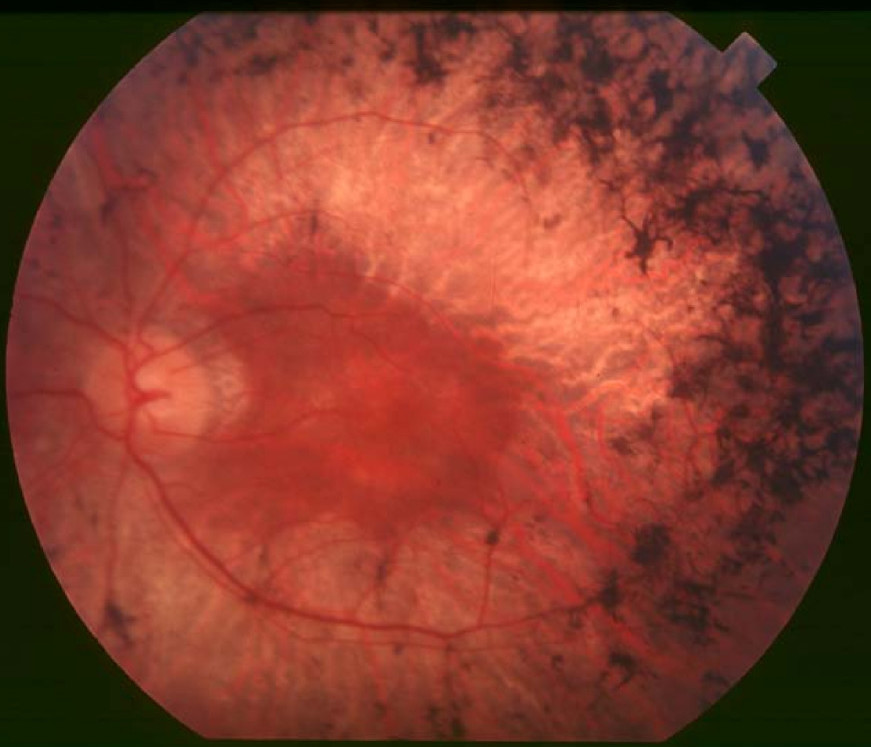Cone-Rod Dystrophy 2
Watchlist
Retrieved
2022-04-26
Source
Trials
—
Genes
C8orf37,
PDE6B,
PDE6A,
CRX,
RPGR,
RPE65,
PDE6G,
LRAT,
ABCA4,
EYS,
MERTK,
IMPDH1,
ROM1,
RHO,
USH2A,
CRB1,
CNGB1,
RPGRIP1,
GUCY2D,
RP2,
NRL,
RBP3,
CLRN1,
RDH12,
SAG,
SPATA7,
CNGA1,
ARL6,
AIPL1,
REEP6
C8orf37,
PDE6B,
PDE6A,
CRX,
RPGR,
RPE65,
PDE6G,
LRAT,
ABCA4,
EYS,
MERTK,
IMPDH1,
ROM1,
RHO,
USH2A,
CRB1,
CNGB1,
RPGRIP1,
GUCY2D,
RP2,
NRL,
RBP3,
CLRN1,
RDH12,
SAG,
SPATA7,
CNGA1,
ARL6,
AIPL1,
REEP6,
RGR,
DHX38,
GUCA1B,
OFD1,
IDH3A,
IDH3B,
PRPF8,
RP1,
FAM161A,
TULP1,
SNRNP200,
PRPF31,
CERKL,
NR2E3,
CA4,
MAK,
PRCD,
PRPF3,
RLBP1,
PROM1,
PCARE,
CHM,
ARL2BP,
TOPORS,
BBS1,
CYP4V2,
BEST1,
DHDDS,
KLHL7,
IMPG2,
HGSNAT,
IFT140,
PRPF6,
BBS2,
TTC8,
AHI1,
SCAPER,
CLN3,
IFT172,
CDHR1,
KIZ,
FLVCR1,
TTPA,
ARL3,
PRPF4,
AGBL5,
RP9,
SLC7A14,
FSCN2,
POMGNT1,
ZNF513,
ZNF408,
RBP4,
ABHD12,
UNC119,
NEK2,
AHR,
TUB,
SEMA4A,
ATF6,
IFT88,
FOXI2,
UBAP1L,
CCZ1B,
CROCC,
PDAP1,
FAM71A,
KIAA1549,
IRX5,
ARHGEF18,
C1QTNF5,
PRTFDC1,
SLC37A3,
NAALADL1,
CRB2,
NGF,
CEP250,
CWC27,
CCDC66,
GRIN2B,
PRPH2,
AGTPBP1,
SLC6A6,
AIFM1,
FGFR2,
KL,
MT2A,
PTEN,
MYO7A,
CEP290,
GUCA1A,
RDH5,
CDH23,
IQCB1,
MSTO1,
CACNA1A,
BBS4,
ATXN7,
USH1C,
CFAP410,
ATP6,
PANK2,
MKKS,
BBS9,
SLC24A1,
PEX1,
RP1L1,
HADHA,
PNPLA6,
SDCCAG8,
BBS12,
NDUFAF5,
RRM2B,
PDHA1,
NDUFS8,
NDUFV2,
LZTFL1,
FOXRED1,
POMT2,
RCBTB1,
TST,
FKRP,
BBS7,
CNGB3,
NCAPG2,
NPHP1,
MKS1,
NDUFB11,
SURF1,
SDHB,
PEX2,
WDPCP,
PRPH,
NDUFV1,
NDUFA13,
SCN1A,
SCO1,
SDHA,
SDHD,
PHYH,
TACO1,
LIPT1,
SLC19A1,
NDUFA12,
PEX5,
NGLY1,
ALMS1,
LARGE1,
NDUFS4,
PRDX1,
NDUFS3,
POLR3A,
MFSD8,
ZDHHC24,
RNASEH1,
CTNS,
ARL13B,
TRIM32,
NIPAL1,
ECHS1,
FASTKD2,
ERCC3,
POMT1,
ERCC6,
ERG,
IFT27,
NDUFAF6,
BBS5,
NDUFS2,
CLRN1-AS1,
COX20,
CYGB,
COX15,
COX10,
COX8A,
COX7B,
CDH23-AS1,
ACOX1,
C8orf37-AS1,
MMACHC,
JAG1,
AMACR,
AIRE,
PET100,
SDHAF1,
ZFYVE26,
PHF3,
ATP1A2,
BCS1L,
NDUFS7,
CAV1,
TTLL5,
VSX2,
ERCC8,
COX6B1,
PRRT2,
MTFMT,
GSS,
COL18A1,
GMPPB,
HADHB,
ND1,
ND2,
ND3,
ND4,
ND5,
ND6,
TRNK,
TRNL1,
TRNN,
TRNS1,
TRNV,
TRNW,
TRIM37,
BBS10,
NDUFA2,
NDUFA4,
NDUFA9,
NDUFA10,
NDUFS1,
SLC19A3,
WFS1,
BBIP1,
COA8,
HCCS,
NDUFAF2,
HADH,
TMEM14B,
COX14,
PLXNA2,
LSM2,
TRNT1,
CLU,
MFRP,
PCDH15,
DHX16,
PTPRC,
SLU7,
KLK3,
SIGMAR1,
NXNL1,
CLTA,
CNTF,
NT5C2,
RPE,
PROS1,
PLAG1,
NPHP4,
TIMP3,
PSAT1,
NPEPPS,
MYP2,
CXCR6,
RIMS1,
RRH,
SLC19A2,
EXOSC2,
ADIPOR1,
LPAR2,
USP9X,
COG4,
VCP,
EDN1,
LCA5,
PDC,
ATN1,
OTX2,
OTC,
CNOT3,
MVK,
LPCAT1,
MMP9,
EDNRA,
RCC1,
EPO,
INS,
FANCF,
HSPA4,
HK1,
GNAT1,
HIF1A,
OPN4,
GSN,
SERPINF1,
GPR42,
NSMCE3,
GRK1,
ALDH3A2,
SFRP2,
ACKR3,
ADRA1A,
ARL2,
ATXN2,
CC2D2A,
ADRA2B,
WDR19,
SOD3,
PLIN2,
SSTR4,
BRS3,
STC1,
ACTB,
NRG4,
TWIST2,
GRK7,
POC5,
ARMS2,
MFT2,
SAMD11,
SAMD7,
NOC2L,
JAKMIP1,
MIR204,
POLDIP2,
GUCY2EP,
LIN28B,
NPHP3,
ARSI,
RD3,
CENPV,
PITPNM3,
INVS,
CENPK,
TENT5A,
CYCS,
DCUN1D1,
TWNK,
SLC2A4RG,
TBX20,
RDH11,
PNPLA2,
KIDINS220,
NGB,
MPP4,
NYX,
TNMD,
ENFL2,
TUT1,
DNER,
FTO,
ELOVL6,
ALG12,
RNF19A,
COQ8B,
SETD2,
KLF15,
PDZD7,
HKDC1,
C5AR2,
DNAJC17,
ADGRV1,
CEP78,
GNPTG,
AAVS1,
THBS2,
WHRN,
MMP2,
HMOX1,
HK2,
HGF,
GRM5,
GRM1,
GRB10,
GLO1,
GK,
GJB2,
GDNF,
GDF2,
G6PD,
FRZB,
FN1,
FGF5,
FGF2,
FBN2,
HSP90AA1,
IDH2,
IFNG,
INSR,
MEIS2,
MDH1,
MAP1A,
SMAD4,
LTB,
LAMP1,
ISG20,
ING1,
IGF1,
IMPA1,
CXCL8,
IL6,
IL2RA,
IL1B,
IL1A,
CCN1,
FASN,
ETV5,
ERN1,
ALDH7A1,
CACNA1F,
C5AR1,
C3,
C1QBP,
BSG,
BMP4,
BCL2,
ARRB2,
CANX,
ARR3,
ABCC6,
APOE,
APOB,
AMFR,
ADH7,
ABO,
CACNA1S,
CCT,
ERBB2,
CYBB,
EGF,
E2F1,
DUSP6,
DNMT3A,
CFD,
ACE,
CYLD,
CTNNB1,
CD44,
MAPK14,
CRYAB,
CRK,
CP,
CORD1,
COL2A1,
CD74,
RAB8A,
MSR1,
SH3BP4,
CYTB,
SYNJ1,
FGF18,
HSD17B6,
DGKE,
BRAP,
SMC1A,
USP11,
AIMP2,
PAX8,
ZNF132,
ZFP36,
USH1E,
TSC1,
TP53,
TNF,
TMPRSS2,
TSPAN7,
SMC3,
ARHGEF2,
CRLF1,
AKT3,
TMED3,
SIRT1,
ARC,
MAPRE3,
ARPP21,
AHSA1,
PPIH,
HEPH,
SNAP29,
PLEKHM1,
PHYHIP,
HDAC4,
KNTC1,
EIF2AK3,
GRAP2,
EFTUD2,
TIMP2,
TIMP1,
DYNLT3,
PKNOX1,
HTRA1,
PRNP,
MAPK1,
PRKCG,
POLG,
PMM2,
PLAU,
PIM1,
RAC1,
PGF,
CFP,
PDGFRB,
NPTX2,
NFE2L2,
NAGLU,
MYC,
ALDH18A1,
RASGRF1,
ELOVL4,
SFTPD,
STATH,
SOS1,
SOD1,
SNRPB,
SNCA,
SLC2A1,
SGSH,
SFRP5,
RBP1,
SEC14L1,
CX3CL1,
CCL2,
S100A6,
RPS6KB1,
RPS6,
RCVRN,
H3P22
Drugs
—
Registered!

Cone-rod dystrophy 2 (CORD2) is an inherited eye disorder that affects the rod and cone cells in the retina. These cells process light and allow people to see the accurate shape and color of objects. Initial signs and symptoms of CORD2 usually occur in early childhood or late adolescence and include decreased sharpness of vision (visual acuity) and increased sensitivity to light (photophobia). Severity of symptoms and rate of disease progression may vary; however, most individuals experience impaired color vision, blind spots, loss of peripheral vision, and night blindness by adulthood. CORD2 is caused by mutations in the CRX gene and is inherited in an autosomal dominant manner. Though future treatment options such as gene therapy show promise in research studies; management currently focuses on slowing down the disease process, treating the complications and helping individuals to cope with the social and psychological impact of blindness.